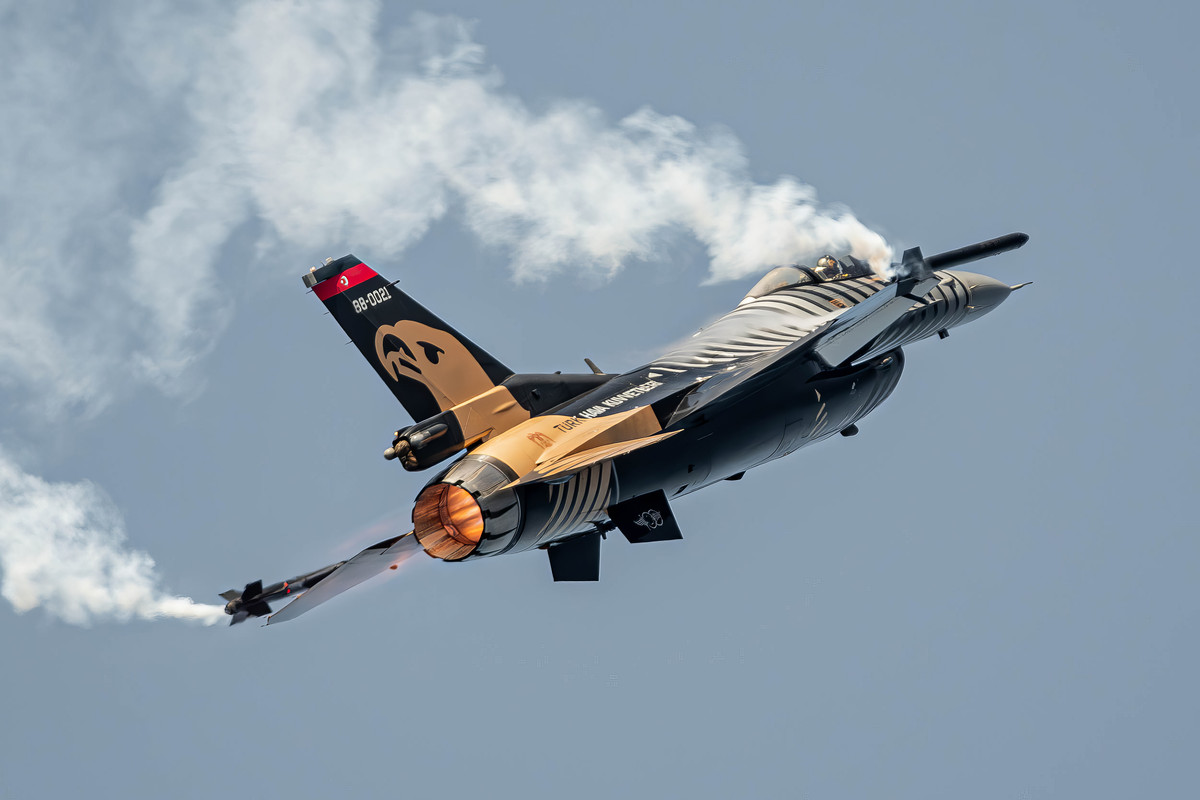
SoloTurk
SoloTürk
SoloTürk is the Turkish Air Force's elite single-aircraft aerobatic demonstration team, renowned for showcasing the agility and power of a specially-painted General Dynamics F-16C Block 40. Stationed at Konya Air Base under the 132nd Squadron, this skilled ensemble of pilots and support staff captivates audiences at airshows across Turkey and beyond with daring and precise maneuvers. The team represents the pinnacle of aerobatic excellence, blending military precision with breathtaking spectacle.
The team’s journey began with its establishment in the late 2000s, followed by a meticulous pilot selection and training process. SoloTürk took flight with its initial private demonstration for military personnel, soon after making a grand public debut during the Turkish Air Force’s centennial celebrations. Originally based at Akıncı Air Base, the team later relocated to Konya following significant operational changes, cementing its place as a celebrated part of Turkish aviation heritage.
SoloTürk’s performances have earned widespread praise, securing prestigious awards from renowned events like the Royal International Air Tattoo and the Slovak International Air Fest. Highlights of their displays include an audacious low approach at the Waddington International Airshow and the groundbreaking cobra maneuver, a first for an F-16 in aerobatic demonstration. These feats underscore the team’s reputation for pushing boundaries while upholding impeccable safety standards.
Each show is a 20-minute display of aerial artistry, featuring around 20 distinct maneuvers such as the signature SoloTürk roll and the striking cobra maneuver. Operating at speeds between 100 and 1,200 knots and skimming as low as 100 feet, the F-16 demonstrates its versatility under the expert control of its pilots. The team comprises two pilots, two support personnel, and nine maintenance crew members, whose seamless collaboration ensures every performance soars to perfection.
About the F-16
The F-16 Fighting Falcon, developed by General Dynamics (now Lockheed Martin), emerged in the 1970s as a lightweight, multirole fighter designed for agility, affordability, and versatility. It originated from the U.S. Air Force’s Lightweight Fighter program, which aimed to create a cost-effective complement to the heavier F-15 Eagle. The F-16 first took flight in 1974 and officially entered service in 1978, introducing innovations like fly-by-wire controls and a bubble canopy for superior pilot visibility. Its ability to handle both air-to-air combat and air-to-ground missions made it a standout design
Over the decades, the F-16 has evolved through continuous upgrades, incorporating advanced avionics, radar systems, and precision weapons. More than 4,600 F-16s have been built, and the aircraft has been exported to 25 countries, cementing its status as one of the most widely used fighter jets in the world. Its adaptability and relatively low operating costs have kept it relevant, with production and modernization efforts continuing into the 21st century.
Specifications
Crew
1 F-16C / 2 F-16D
Length
49 ft 5 in (15.06 m)
Wingspan
32 ft 8 in (9.96 m)
Height
16 ft (4.9 m)
Max Speed
Mach 2.05 (2,178 km/h; 1,353 mph; 1,176 kn)
Combat Range
295 nmi (339 mi, 546 km)
Service Ceiling
50,000 ft (15,000 m)
Thrust/weight
1.095
F-16 in the Turkish Air Force
The Turkish Air Force (TuAF) began operating the F-16 in the 1980s under the Peace Onyx program, a major initiative to modernize its fleet. Turkey didn’t just acquire the aircraft—it became a key player in its production, assembling F-16s and manufacturing parts through Turkish Aerospace Industries (TAI). This partnership boosted Turkey’s aerospace industry and strengthened its defense capabilities. The TuAF’s F-16s have since played critical roles in border security, counterterrorism efforts, and NATO missions.
Turkey has upgraded much of its F-16 fleet to the Block 50+ standard, adding advanced radar, conformal fuel tanks, and precision-guided munitions. With dozens of F-16s in service, the aircraft remains a backbone of Turkish airpower, reflecting both its strategic importance and the F-16’s enduring versatility.
Did You Know?
- The F-16 was the first fighter jet to use a fly-by-wire flight control system, replacing traditional mechanical linkages with electronic controls for greater precision and agility.
- The F-16's cockpit canopy is designed without a frame, providing the pilot with an unobstructed 360-degree view, a feature that enhances situational awareness during combat.
- The F-16 can perform a 9G turn, subjecting the aircraft and pilot to nine times the force of gravity, showcasing its exceptional maneuverability.
- Since its introduction, the F-16 has been used in over 100,000 combat missions, making it one of the most battle-tested fighter jets in history.
- The F-16's engine, either the Pratt & Whitney F100 or General Electric F110, can produce up to 29,000 pounds of thrust, enabling the aircraft to reach speeds of Mach 2.05.
Test Your Knowledge
1. What is the maximum takeoff weight of the F-16?














































